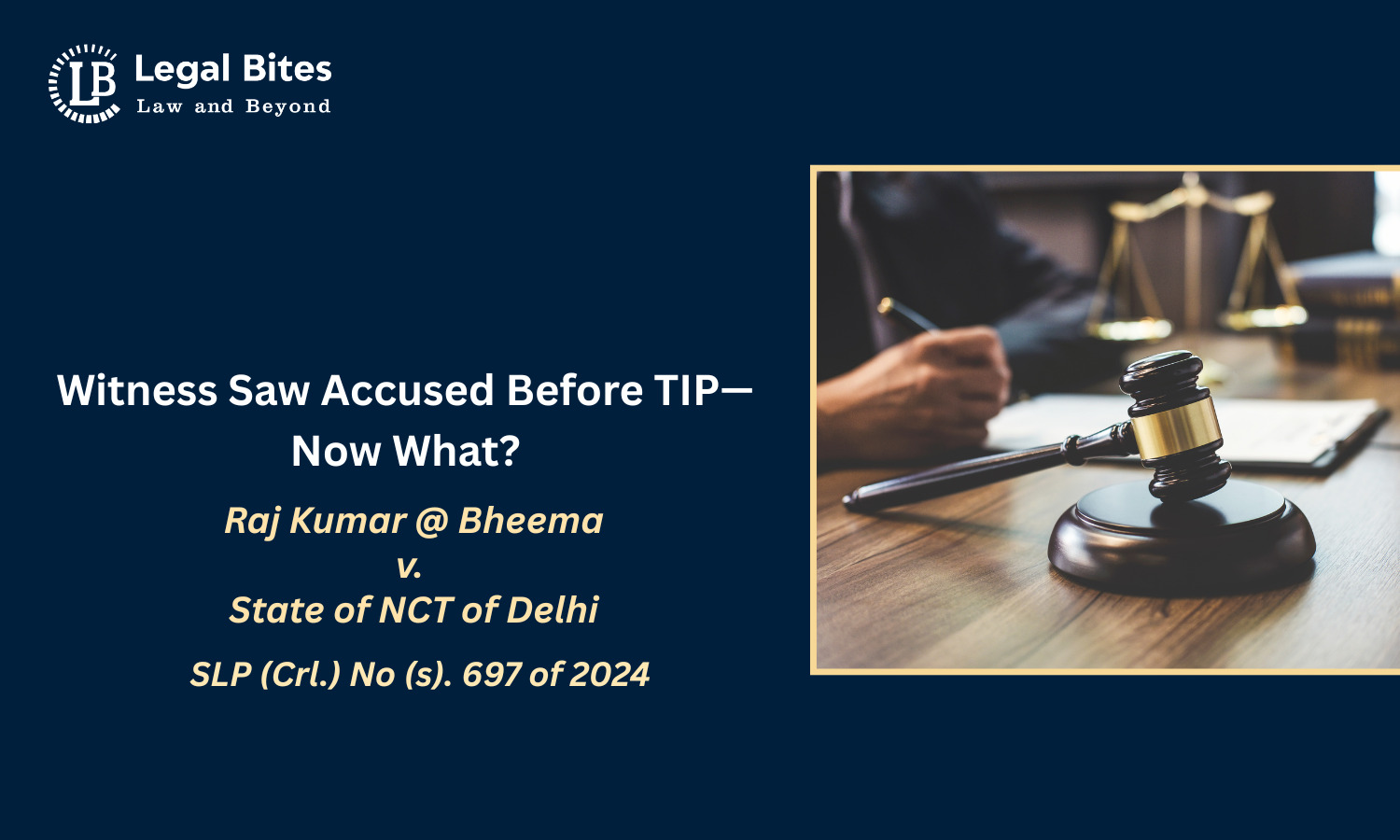
In criminal trials, identification of the accused plays a crucial role, especially when the prosecution’s case relies on eyewitness testimony. Test Identification Proceedings (TIP) are usually conducted during the investigation to confirm whether a witness can identify an accused among a group of persons. Though not substantive evidence in itself, a properly conducted TIP can significantly strengthen the prosecution’s case by corroborating in-court identification.
However, the evidentiary value of such proceedings diminishes drastically if it emerges that the witness had a prior opportunity to see the accused before the TIP. This principle was reaffirmed in the 2025 Supreme Court judgment in Raj Kumar @ Bheema v. State of NCT of Delhi, where the apex court held that when TIP is rendered unreliable due to such prior exposure, subsequent dock identification loses credibility, especially when delayed by several years.
Background of the Case
The appellant, Raj Kumar alias Bheema, was convicted under Section 302 of the Indian Penal Code (IPC) for allegedly murdering a senior citizen during a robbery at his residence in November 2008. The accused was also charged under various provisions of the Maharashtra Control of Organised Crime Act (MCOCA), but was acquitted of those charges. After multiple rounds of appeals, the matter reached the Supreme Court.
The prosecution’s case rested primarily on the testimony of the sole eyewitness and victim, Smt. Indra Prabha Gulati, who had sustained serious injuries during the incident. The TIP allegedly conducted for the identification of the accused was refused by the appellant, and he was later identified in court through video conferencing almost eight-and-a-half years after the incident. This identification became the crux of the case.
Supreme Court’s Analysis
The apex court pointed out several serious infirmities that undermined the prosecution’s case. The key findings and legal reasoning are summarised as follows:
1. Delayed Dock Identification and Weak Testimonial Reliability
One of the most significant points was the fact that the witness identified the accused through video conferencing after more than eight years. At the time of the incident, the witness was 73 years old and visually impaired (requiring spectacles), and at the time of deposition had no spectacles on. These factors cast substantial doubt on the reliability of the dock identification.
The Court observed:
“It is trite that the evidence of an eyewitness must be of sterling quality and unimpeachable character. The possibility of identification after such long delay under compromised conditions needs to be treated with caution.”
This aligns with prior judgments such as Jaspal Singh v. State of Punjab (1979) and Vijay @ Chinee v. State of Madhya Pradesh (2010), where courts stressed that dock identification loses significance unless supported by a prompt and untainted TIP.
2. Unreliable TIP and Previous Exposure to the Accused
The Court highlighted material contradictions about whether the accused’s face was kept covered after arrest and whether witness identification was attempted in compliance with prudent procedure. It emerged that:
- There was no clear evidence that the accused was kept baparda (face covered) after arrest.
- The identifying witness denied attending any TIP or court for identification.
- No signatures of the witness were found on TIP documents.
The Court held:
“Where the witnesses have had an opportunity to see the accused prior to the TIP, the evidentiary worth of such proceedings stands considerably diminished.”
TIP is meant to test the memory of the witness under unbiased conditions. If the accused is shown to the witness beforehand – whether physically or through photographs – the very purpose of the TIP collapses.
3. Contradictions and Material Improvements
The witness made significant improvements in court over her statement under Section 161 CrPC recorded immediately after the incident. She mentioned identifying features and weapons (like a chheni and rod) for the first time at trial, which were not mentioned in her earlier statement. The Court treated this as a material improvement.
As per State v. V.C. Shukla (1980), improvements that go to the root of the case cast doubt on the witness’s credibility.
Evidence, Recoveries, and Misplaced Inference
The prosecution attempted to rely on recoveries of the weapon and stolen items based on the accused’s alleged disclosures. However, multiple lapses weakened this position:
- A blood-stained pant recovered at the instance of the accused could not be matched with the blood samples from the scene.
- Recoveries lacked independent witnesses.
- Significant articles were not identified in court by the witness.
The Supreme Court held that even these evidentiary pieces, when viewed in light of the flawed identification process, could not establish guilt beyond a reasonable doubt.
Outcome
Finding the High Court and trial court judgments flawed, the Supreme Court set aside the conviction and ordered the immediate release of the appellant, noting:
“Once her identification of the accused-appellant in Court is discarded, no substantive evidence remains on record to connect the accused with the crime.”
This case serves as a crucial precedent reinforcing the principle that test identification is only of value if the process is fair, unbiased, and scientifically compliant.
Important Link
Law Library: Notes and Study Material for LLB, LLM, Judiciary, and Entrance Exams